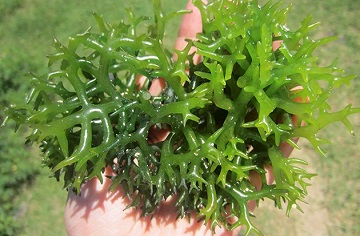A Group of IPB Students Optimized Seaweed Products Utilizing Vacuum Drying Method

Who have never seen any seaweed? Seaweed refers to several species of macroscopic, multicellular, marine algae. Algae, a vital group of bacteria and plants in aquatic ecosystems, it has been recognized as an export commodity. It is a major source of income for tens of thousands of small Indonesian farmers, as well as collectors, traders, exporters, and producers. Seaweed production continues to increase annually. Data from the Ministry of Maritime Affairs and Fisheries (KKP) RI in 2015 showed that seaweed production in Indonesia reached 3.9 million tons in 2010 and continued to increase to reach 10.1 million tons in 2014. Indonesia is striving to produce 10 million tons of seaweed per by 2015, making it the number one producing country.
"Kappaphycus alvarezii", or commonly known Eucheuma cottoniiis is a species of red algae. It is one of the most important commercial sources of carrageenans, a family of gel-forming, viscosifying polysaccharides. Statistical data released by the Food and Agriculture Organization (FAO) in March 2015 showed that the production of Indonesian seaweed Kappaphycus alvarezii reached 8.3 million tons, thus Indonesia is the world’s largest producer of Eucheuma. It is the unprocessed seaweed export commodity.
Semi Refined Carrageenan (SRC) or semi-pure carrageenan is one of the products produced from the processing of seaweed Kappaphycus alvarezii. SRC has a lower purity level compared to Refined Carrageenan or pure carrageenan. Carrageenan is widely used in food industry as stabilizer, emulsifier, thickener and gelling agent (gel maker). However, the disadvantage of the traditional sun drying process of SRC the method requires extensive land, it depends on the weather, and causes environmental pollution. In addition, the low quality of SRC will lower its selling prices.
To overcome this, a group of Bogor Agricultural University (IPB) students who are members of Program Kreativitas Mahasiswa bidang Penelitian (PKM-P Student Creativity Program for Research) carried out the study program to see and test alternative ways for maintaining the quality of the SRC. Ahmad Khoeron and 3 (three) other IPB students implemented their study on using vacuum drying method or vacuum dryer. The use of vacuum-drying methods on foodstuffs may improve its quality may reduce the deterioration of nutrient content. In addition it will also maintain its characteristics.
"The vacuum drying method dries an object with a temperature of 25ºC three times faster than the traditional sun drying process," Khoeron said.
Vacuum drying is the mass transfer operation in which the moisture present in a substance usually wet solid is removed by means of creating vacuum. The vacuum drying is a batch operation and at reduced pressures the relative humidity is also lower and that is why the drying occurs faster. In chemical process industries like food, pharmaceutical, and agricultural, etc. drying is an essential unit operation to remove the moisture from various substances to get a solid finished product. In vacuum drying, advantage is taken of the fact that evaporation of water occurs more readily at lower pressures than at higher ones. Heat transfer in vacuum drying is generally by conduction, sometimes by radiation. in addition the vacuum drying process is ideal for heat sensitive materials.
"We look forward that the preparation of SRC from Kappaphycus alvarezii utilizing vacuum drying method to improve its quality will be widely used, at the end the use of vacuum drying method for SRC industrial is recommendable," he added. (Wied)



